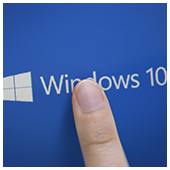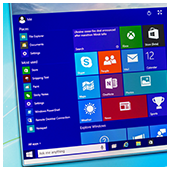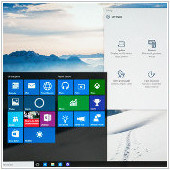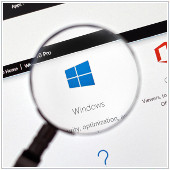Windows 10 delivers comprehensive protection with built-in security features, including anti-virus firewalls and windows defender. The operating system also updates itself regularly to keep your security current and to continuously help safeguard against threats. Unfortunately, nothing is perfect, and Microsoft has announced some dangerous flaws hiding within Windows 10. But fret not, they’ve released patches […]
 Windows 10 delivers comprehensive protection with built-in security features, including anti-virus firewalls and windows defender. The operating system also updates itself regularly to keep your security current and to continuously help safeguard against threats. Unfortunately, nothing is perfect, and Microsoft has announced some dangerous flaws hiding within Windows 10. But fret not, they’ve released patches for them all, and we’ve got the details right here.
Windows 10 delivers comprehensive protection with built-in security features, including anti-virus firewalls and windows defender. The operating system also updates itself regularly to keep your security current and to continuously help safeguard against threats. Unfortunately, nothing is perfect, and Microsoft has announced some dangerous flaws hiding within Windows 10. But fret not, they’ve released patches for them all, and we’ve got the details right here.
Internet Explorer
In its Windows 10 announcement, Microsoft clarified that it found four zero-day flaws, which are vulnerabilities that have never been seen before. Of the four, the most concerning is the one that allows cyberattackers to remotely take control of your machine with full administrative rights via Internet Explorer. All that is required to deploy the malware is visiting a website with the corresponding code.Office
Microsoft Office also has a critical flaw that grants attackers the ability to corrupt memory and abuse privileges inherent to the user who opened the mischievous Office document. By amending how documents are saved and how code within a document is executed, Microsoft believes users will be much safer from email attachment schemes.Exchange Server
For companies with on-premise servers, Microsoft Exchange Server patches need special attention. Without them, a malicious email could grant cyberattackers the ability to remotely insert and execute commands within the server. Patch MS16-108 provides cumulative updates and changes the way hotfixes and service packs are delivered. Lastly, it tries to ensure Microsoft Exchange Server follows a scheduled delivery model.Microsoft Graphics
This security update for the Microsoft Graphics component of Windows 10 is considered ‘critical’ because of its presence throughout the entire operating system. Patch MS16-106 removes vulnerabilities in graphics processing protocols that would allow attackers to remotely control and exploit target systems.If your desktops have not automatically updated themselves, users can trigger a manual update by opening the Settings window, selecting Update & Security, and finally Windows Update. Once there, simply select Check for Updates and follow the prompts to download and install the necessary updates.
Managing one machine is hard enough. If you're struggling to keep an entire office up and running, chances are you feel like you’re treading water in steel-toed boots. For total monitoring and maintenance of all your Windows machines, call us today -- we’ll throw you a lifeline and pull you aboard.

 At one point, Microsoft claimed it could convince 1 billion users to use their Windows 10 operating system. Obviously that’s an unattainable goal for the foreseeable future, but it hasn’t stopped Microsoft from releasing tools to push more people to their software. With its sights set directly on business deployments of the operating system, the tech giant has released a new tool to oil the gears of large-scale migrations. We’ve got all the details on the forthcoming software right here.
At one point, Microsoft claimed it could convince 1 billion users to use their Windows 10 operating system. Obviously that’s an unattainable goal for the foreseeable future, but it hasn’t stopped Microsoft from releasing tools to push more people to their software. With its sights set directly on business deployments of the operating system, the tech giant has released a new tool to oil the gears of large-scale migrations. We’ve got all the details on the forthcoming software right here. Regardless of the app, platform, or operating system, digital notifications are a tricky business. Our devices are overcrowded with software of varying importance, and without proper customization the stream of information can become overwhelming. Thankfully, Windows 10’s action center is built atop a solid foundation -- it just needs a bit of help. If Windows notifications are driving you up a wall, try out the three steps we’ve listed here to get them under your thumb.
Regardless of the app, platform, or operating system, digital notifications are a tricky business. Our devices are overcrowded with software of varying importance, and without proper customization the stream of information can become overwhelming. Thankfully, Windows 10’s action center is built atop a solid foundation -- it just needs a bit of help. If Windows notifications are driving you up a wall, try out the three steps we’ve listed here to get them under your thumb.
 Unlike those who attend Hogwarts, magicians rely mainly on subtle sleight of hand to convince others that they managed to make coins disappear into thin air. The same concept applies to ransomware. How can it complete its mission in a suit labeled with the word “Villain”? Nowadays, ransomware fashions various disguises that render it undetectable. A case in point is Fantom -- here are some of the reasons why you should steer clear of this technological spook.
Unlike those who attend Hogwarts, magicians rely mainly on subtle sleight of hand to convince others that they managed to make coins disappear into thin air. The same concept applies to ransomware. How can it complete its mission in a suit labeled with the word “Villain”? Nowadays, ransomware fashions various disguises that render it undetectable. A case in point is Fantom -- here are some of the reasons why you should steer clear of this technological spook.